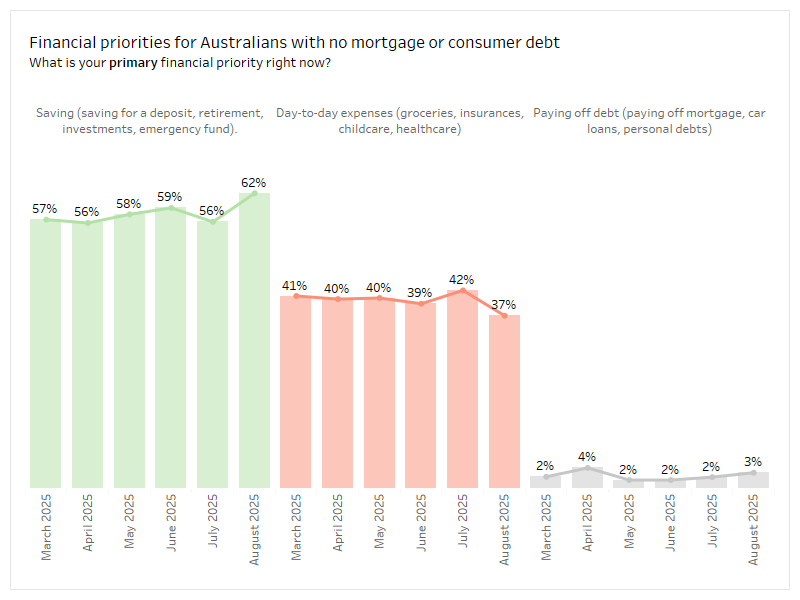
Agile Market Intelligence’s Consumer Pulse surveys around 1,500 Australian consumers a month to monitor consumer sentiment, financial stress, and behavioural shifts across key household segments. As interest rates were cut in August 2025, we take a look at how different consumer types shift their financial priorities.
Key stats you need to know
- 62% of debt-free Australians prioritise saving this August 2025, up 6% from July.
- While paying off debt is still top priority for mortgage holders, it eased by 3% from last month.
- Consumer debt holders shifted from prioritising debt repayment (down 6%) to saving (up 3%) and addressing day-to-day expenses (up 3%).
Mortgage holders remain focused on debt, but the pressure is easing
- 63% of mortgage holders say debt repayment is their top priority, down from 66% in July.
- 11% are focused on day-to-day expenses, up from 9% in July.
- 26% say saving is their top priority, stable over the past 6 months.
Just over a quarter of mortgage holders have consistently prioritised saving in the past 6 months. That number has largely been unchanged in August. Paying off debt remains the leading priority, 63% of households reporting it so. However, this figure is down 3% from July, and is the lowest observed since March. Simultaneously, an uptick is observed for those focusing on day-to-day expenses, signaling some breathing room as financial pressure begins to rebalance.
“Mortgage holders are still focused on reducing debt, but we’re starting to see signs of flexibility in their budgets. With rate cuts on the horizon, many are cautiously shifting attention toward household costs, ” said Michael Johnson, Research Director at Agile Market Intelligence.

Consumer debt holders shift from debt repayment to saving
- Consumer debt holders experienced the largest shifts in financial priority this August, with a 6% drop in the proportion prioritising debt repayment.
- 25% of consumer debt holders now prioritise day-to-day expenses, up 4% from July.
- Savings overtakes paying off debt at the top financial priority (38%) for consumer debt holders in August 2025.
August signals a change in mindset for Australians carrying consumer debt. The proportion of this group prioritising debt repayment has dropped from 43% in July to 37% in August. The 6-point drop is distributed into prioritising day-to-day expenses (up 4%) and saving (up 2%). Although neck and neck, saving has overtaken debt repayment as the top priority for consumer debt holders this month.
“We’re seeing a turning point among consumer debt holders. Saving is now just as important as paying off debt, which suggests a growing sense of financial control, or at least the intent to get ahead, ” said Michael Johnson.

Debt-free Australians are doubling down on saving
- 62% of debt-free Australians prioritise saving, up from 56% in July.
- 37% focus on day-to-day expenses, down from 42%.
We define ‘debt-free’ as households with no mortgage or consumer debt. For this group, saving remains the clear focus - and it’s growing. In August, 62% of mortgage-free and consumer debt-free Australians reported saving as their top financial priority, up from 56% from July. The shift is largely driven by a decline in prioritising day-to-day expenses, which is at the lowest point since March. This group is also the only demographic that reports an increase in debt repayment (for debt types other than a mortgage or consumer debt).

About the research
This article is based on findings from Agile Market Intelligence’s Consumer Pulse survey, conducted across March to August 2025. The survey collected responses from 7,971 Australian consumers to date. Results were weighted to reflect national population profiles by age, gender, and state.
The Consumer Pulse is a monthly tracker of over 1,500 Australian consumers developed by Agile Market Intelligence to monitor consumer sentiment, financial stress, and behavioural shifts across key household segments. The survey provides a real-time view of financial wellbeing in Australia, segmented by debt status and home ownership. The sample size for the 1st to 15th of August is 691.


